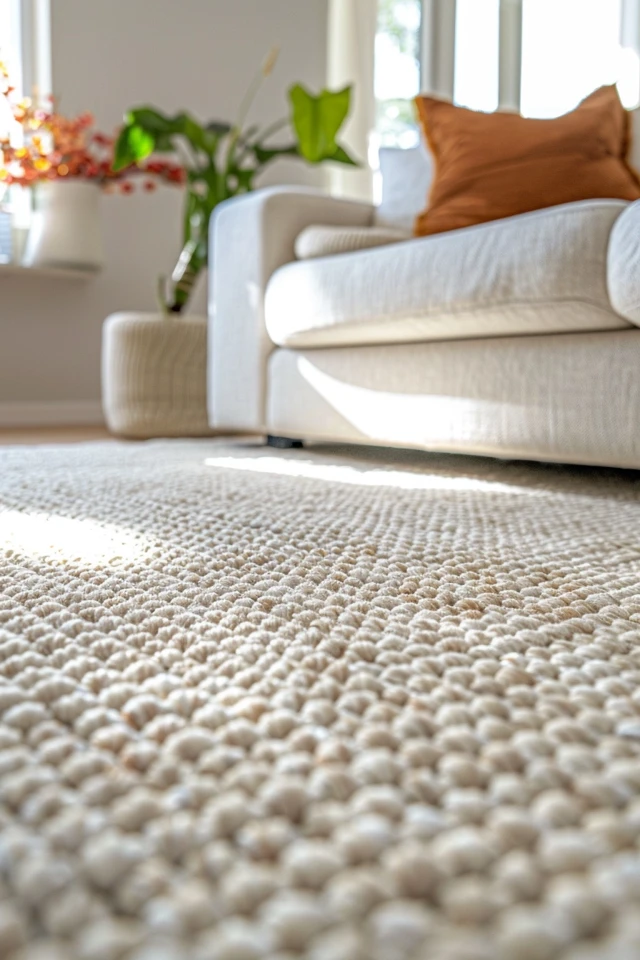Are you looking to lighten the color of your rug or remove stubborn stains? Bleaching a rug can be an effective solution, but it’s important to know the right techniques and when to use them. In this guide, I’ll walk you through the DIY rug lightening process and share rug bleaching techniques to help you achieve a fresh and clean look for your carpet.
Key Takeaways:
- Bleaching a rug can lighten its color and remove stains, but it should only be used as a last resort.
- Before applying bleach, vacuum the carpet and remove any solid substances.
- Wear rubber gloves and a mask to protect your skin and respiratory system from bleach fumes.
- Mix one cup of bleach with one gallon of water before applying it to the rug.
- Let the bleach solution sit for 30 minutes to an hour, then rinse the carpet thoroughly and allow it to dry completely.
Rug Color Restoration Tips
If you have a wool rug that has faded or lost its color, there are various color restoration options to consider. One popular technique is known as an antique wash, which can effectively lighten the colors of the rug. The intensity of the treatment can be adjusted to achieve different results, ranging from a subtle lightening effect to a complete whitewash.
It’s important to note that the antique wash process weakens the fibers of the rug, which may shorten its lifespan. However, for those who are not satisfied with the current color of their rug, this trade-off may be worth it.
Another method for rug color restoration is overdyeing. This process involves adding a new base color to the rug, which can be a neutral tone or a vibrant shade. Overdyeing gives the rug a unique and handmade look, revitalizing its appearance.

When exploring color restoration options, it’s crucial to understand that the final colors and texture of the rug can vary. Different dyes may react differently to the color-lightening chemicals, leading to unexpected color changes. To ensure the best results, it is advisable to consult a specialist who has expertise in carpet dyes and chemicals.
Some companies offer whole-rug color changes, while others may only provide spot repairs for targeted areas. If your rug’s color is beyond restoration or no longer suits your style preferences, consider trading it in for a new one that better fits your aesthetic.
Expert Tip:
“When considering rug color restoration, it’s important to weigh the trade-offs. Antique washes and overdyeing can bring new life to faded rugs, but may impact the rug’s durability. Seek professional guidance and explore your options to make an informed decision.”
Get your rug looking fresh and vibrant again with these helpful color restoration tips.
Key Points:
- An antique wash can lighten the colors of a rug, but it may weaken the fibers.
- Overdyeing involves adding a new base color to the rug, giving it a unique look.
- The final colors and texture of the rug may vary during the color restoration process.
- Consult a specialist for expert advice on rug color restoration.
- Consider trading in your rug for a new one if restoration isn’t possible or desired.

Conclusion
In conclusion, rug bleaching can be a powerful method to lighten the color of your rug and remove stubborn stains. However, it should only be used as a last resort and under specific circumstances. To ensure a safe and effective bleaching process, proper preparation is vital. Start by thoroughly vacuuming the rug and removing any solid debris. Then, protect yourself by wearing rubber gloves and a mask.
Remember, bleach should never be used on wool carpets as it will cause staining. Instead, it is best suited for white or near-white carpets that are heavily stained. Before applying bleach, mix it with water in the correct ratio of one cup bleach to one gallon of water. For white carpets, spray the bleach directly on the stained area. For colored carpets, it is important to spray the entire carpet lightly to maintain uniformity.
After applying the bleach and water solution, allow it to sit for 30 minutes to an hour. Then, rinse the carpet thoroughly with water and use a carpet shampoo and brush to clean. Rinse the carpet one more time and ensure it is completely dry before use. It is worth considering alternative options for rug color restoration, such as antique washing or overdyeing, to achieve the desired results. If you are unsure, consult a specialist to ensure the best outcome for your rug restoration project.
By following these safe rug bleaching techniques and considering other restoration methods, you can confidently restore the color of your rug at home. Whether you choose to bleach, antique wash, or overdye your rug, always prioritize safety and consult professionals when needed. With careful execution and the right approach, you can revitalize the look of your rug and enjoy its beauty for years to come.
Source Links
- https://magiccarpetinc.com/safe-use-bleach-carpets/
- https://www.washingtonpost.com/lifestyle/home/yes-you-can-change-the-color-of-an-disliked-oriental-rug-but-there-might-be-a-better-option/2019/10/04/d266cb76-e392-11e9-a331-2df12d56a80b_story.html
- https://www.apartmenttherapy.com/how-to-whiten-yellowed-wool-215329

